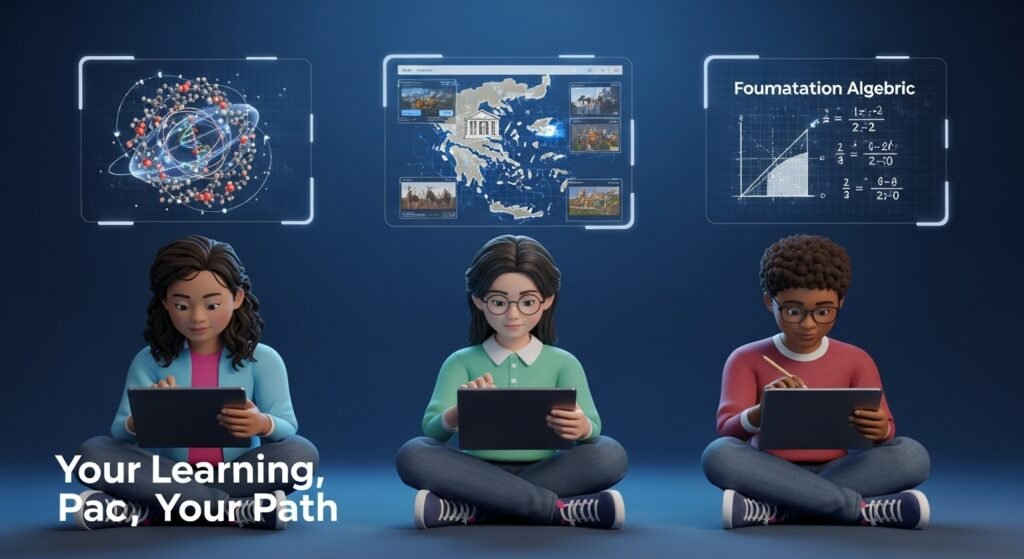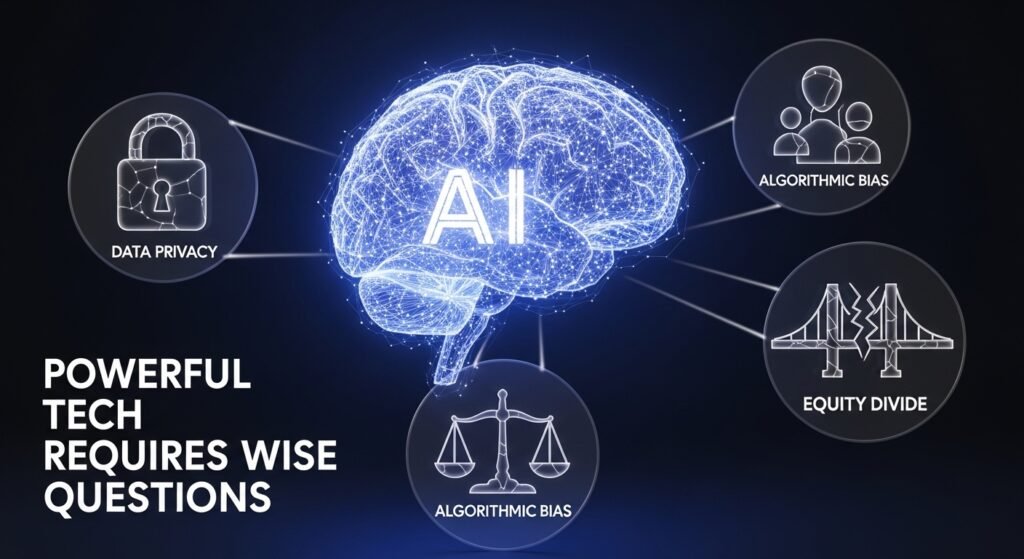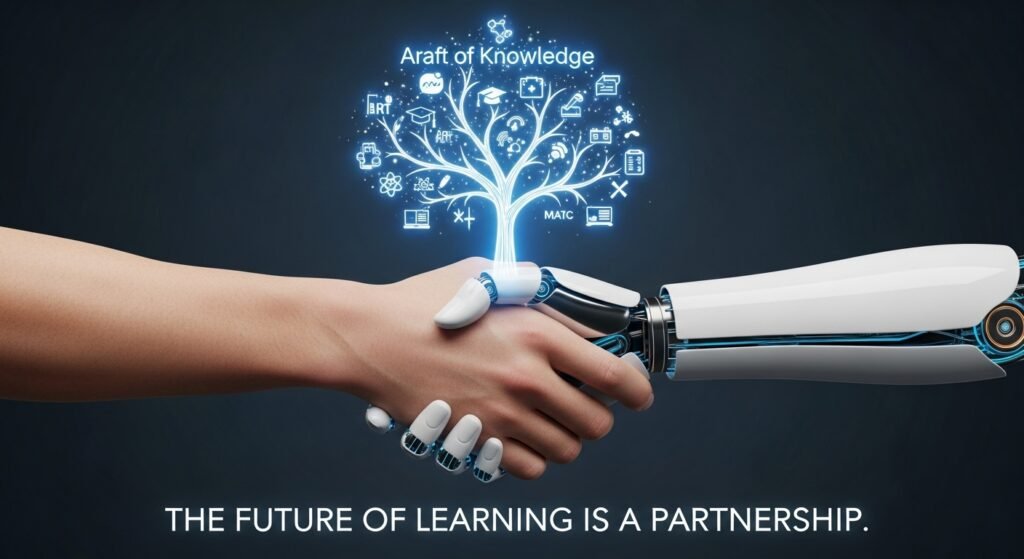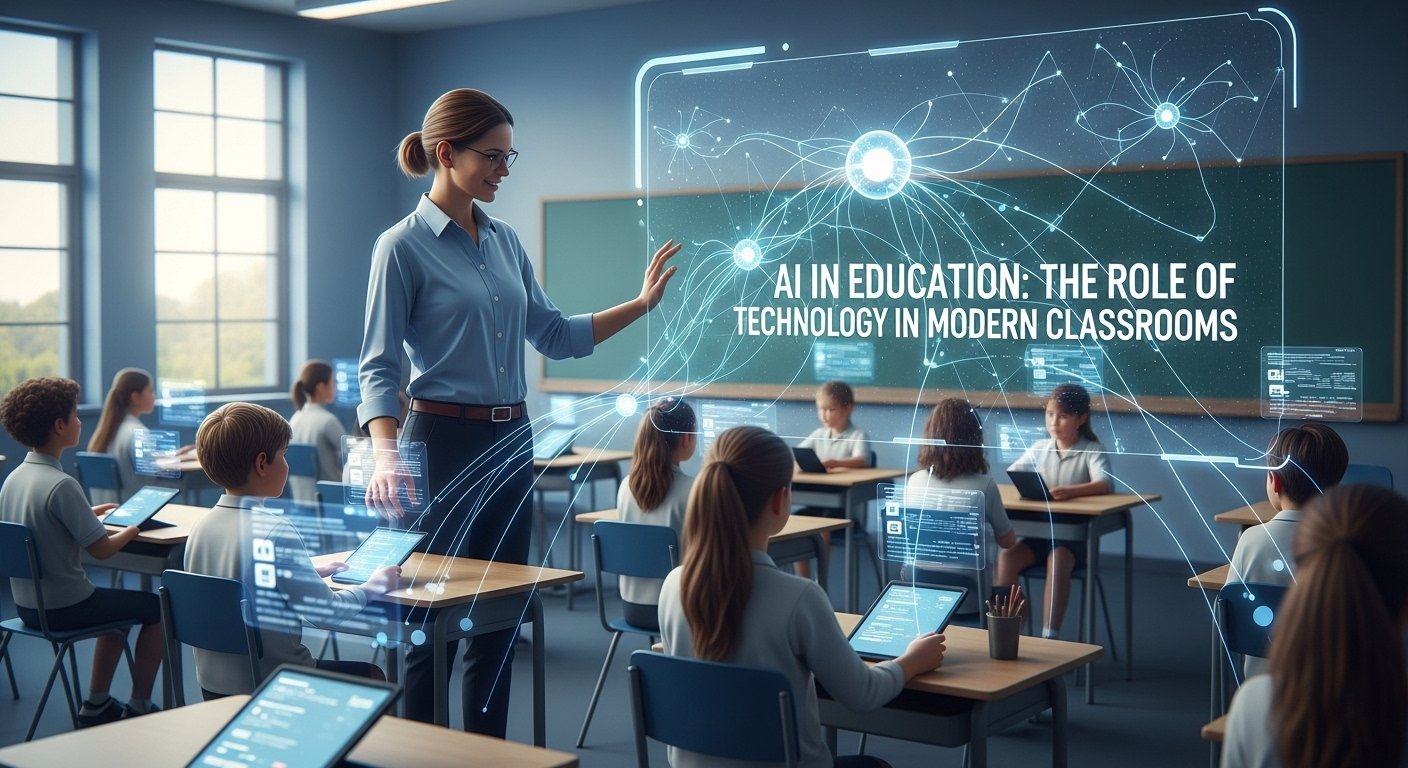The New Teacher’s Assistant: How AI in Education is Reshaping the Modern Classroom
Remember the classic image of a teacher standing at a chalkboard, trying to explain a single concept to a room of 30 students? In that room, there’s a student who is bored to tears because they already get it, a student who is completely lost and afraid to ask a question, and a majority in the middle trying to keep up. For generations, this “one-size-fits-all” approach has been the unavoidable reality of education. But what if that teacher had a silent, super-powered assistant for every single student? An assistant that knows exactly what each child needs at any given moment. This isn’t a futuristic fantasy; as of 2025, it’s the rapidly expanding reality of AI in education.
The explosion of artificial intelligence in the early 2020s has moved from our newsfeeds into our schools, sparking both excitement and apprehension. The initial fears of robots replacing teachers have given way to a more nuanced and powerful understanding. AI in education is not about removing the human element; it’s about augmenting it. It’s about leveraging technology to handle the tedious, the repetitive, and the data-heavy tasks, freeing up our incredible human teachers to do what they do best: inspire, mentor, and connect with their students on a deeper, more personal level.
Beyond the Hype: What AI in Education Really Means in 2025
Let’s clear the air. When we talk about AI in education today, we’re not talking about humanoid robots taking attendance. We’re talking about a sophisticated suite of software and tools designed to create a more personalized, efficient, and insightful learning experience. This technology has matured rapidly and now plays several key roles in the modern classroom.
- Adaptive Learning Platforms: These are the heart of personalization. Imagine a math program that gives a student a problem; if they get it right, the next one is slightly harder. If they struggle, the AI provides a hint, a video tutorial, or a simpler foundational problem, all in real-time. Platforms like a more advanced Khanmigo or DreamBox have become masters at this, ensuring every student is working at their optimal level of challenge.
- Intelligent Tutoring Systems (ITS): These are like having a dedicated tutor on-demand, 24/7. An ITS can guide a student through a complex science simulation, provide step-by-step feedback on a writing assignment, or act as a conversational partner for a student learning a new language.
- Automation of Administrative Tasks: This is the unsung hero of AI in education. AI tools can now auto-grade multiple-choice quizzes, check code for syntax errors, and even provide initial feedback on essay structure, saving teachers countless hours of monotonous work.
- Predictive Analytics: AI dashboards can analyze student performance data and flag potential issues before a student fails. The system might alert a teacher that “Maria has struggled with the last three assignments on fractions,” allowing the teacher to intervene with targeted support long before the end-of-unit test.
Applied Scientific Thinking: A Practical Framework for Real-World Problem-Solving

The Teacher’s New Superpower: How AI Frees Up Educators to Actually Teach
Perhaps the most profound impact of AI in education has been on the teachers themselves. For too long, educators have been buried under an avalanche of administrative tasks, with studies consistently showing that a significant portion of their time is spent on non-teaching activities like grading and data entry.
Automating the Tedious to Unleash the Human
Think about the hours a high school English teacher spends grading basic grammar and spelling on 150 essays. Now, imagine an AI tool that provides that first layer of feedback instantly. The student gets immediate, actionable advice on their mechanics and can revise their work accordingly. The teacher, now freed from that initial burden, can dedicate their grading time to what truly matters: the student’s ideas, their argument, and their unique voice. This is a game-changer, transforming the teacher’s role from a proofreader into an intellectual coach.
From Guesswork to Precision Interventions
A great teacher has always had a “sixth sense” for which students are struggling. AI in education takes that intuition and backs it with data. Modern learning management systems can create a detailed profile for each student, visualizing their strengths, weaknesses, and progress over time.
A teacher can look at a dashboard and see that an entire group of students misunderstood a specific concept from Tuesday’s lesson. They can then pull that small group aside for a targeted re-teaching session on Wednesday, rather than waiting for a test two weeks later to discover the problem. This makes teaching more proactive and incredibly efficient.
The Traditional vs. The AI-Enhanced Classroom
The introduction of these tools creates a fundamental shift in the classroom dynamic, moving from a static, teacher-led model to a fluid, student-centered one.
| Feature | Traditional Classroom (Circa 2015) | AI-Enhanced Classroom (Circa 2025) |
| Instruction | Teacher-centric, one-size-fits-all lecture. | Blend of direct instruction, small-group workshops, and individual work on adaptive platforms. |
| Pacing | All students move at the same speed. | Students progress based on demonstrated mastery of concepts. |
| Assessment | Infrequent, summative (e.g., midterms, finals). | Continuous, real-time formative assessment providing instant feedback. |
| Teacher’s Role | Primary source of information (“Sage on the Stage”). | Facilitator, mentor, and learning architect (“Guide on the Side”). |
| Student Data | Data is collected late and is hard to analyze. | Data is collected in real-time and presented in easy-to-understand dashboards. |
Export to Sheets
This evolution doesn’t diminish the teacher’s role; it elevates it. The teacher is no longer just a content deliverer but a strategic facilitator of learning.
Applied Scientific Thinking: A Practical Framework for Real-World Problem-Solving

A Day in the Life: The Student Experience with AI in Education
To make this concrete, let’s imagine a day in an AI-enhanced 7th-grade classroom.
9:00 AM – Math: Students log into their adaptive learning platform. “Liam,” who excels at math, is immediately presented with complex, multi-step word problems involving pre-algebra concepts. Meanwhile, “Sophia,” who struggles with fractions, is guided through an interactive tutorial that uses visual models to explain division of fractions. The teacher is free to circulate, checking in with Sophia to offer encouragement and challenging Liam with a creative extension project.
11:00 AM – History: The class is learning about ancient Egypt. Instead of just reading a textbook, students use a VR headset to take a virtual tour of the pyramids, guided by an AI narrator. Afterwards, they interact with an AI-powered chatbot that takes on the persona of an ancient scribe, answering their questions about daily life and hieroglyphics.
2:00 PM – English: Students are writing a persuasive essay. They submit their first draft to an AI writing assistant. Within seconds, it provides feedback on their thesis statement’s clarity, identifies run-on sentences, and suggests stronger vocabulary. The students spend 20 minutes revising their work based on this feedback before engaging in peer review, making that human interaction far more productive.
In this model, every student is engaged, challenged at their own level, and receiving constant, personalized feedback. This is the promise of AI in education realized.
How to Apply for Study Abroad Programs in the USA 2025 Guide

The Essential Questions: Navigating the Ethics and Challenges of AI in Education
Of course, this technological shift is not without its challenges. As we integrate these powerful tools into our schools, we must grapple with serious ethical questions. A truly effective approach to AI in education requires us to be as thoughtful about the risks as we are excited about the potential.
- Data Privacy and Security: AI systems are fueled by student data. Who owns this data? How is it being used? How is it protected from breaches? Parents and educators rightfully demand transparency and robust security measures. Organizations like the Student Data Privacy Consortium (SDPC) are working to create standards, but constant vigilance is required.
- Algorithmic Bias: An AI is only as unbiased as the data it’s trained on. If an AI system is trained on data that reflects historical inequities, it can perpetuate or even amplify those biases, potentially penalizing students from certain socioeconomic or racial backgrounds. Auditing these algorithms for fairness is a critical, ongoing task.
- The Equity Divide: What happens to students in underfunded districts that can’t afford the latest AI platforms, VR headsets, and the necessary high-speed internet? There is a significant risk of creating a new “AI divide” that widens the very achievement gaps we are trying to close.
- Over-reliance and Critical Thinking: How do we ensure that AI tools are used to support learning, not circumvent it? We must teach students digital literacy and critical thinking skills, framing AI as a co-pilot, not an autopilot. The goal is to augment human intelligence, not replace it.

Conclusion: A New Partnership for a Brighter Future
AI in education is no longer a question of “if,” but “how.” As of 2025, we’ve moved past the initial hype and are now in the critical phase of thoughtful implementation. The technology is not a silver bullet that will magically solve every problem in education. However, it is an undeniably powerful tool that, when wielded with care, can make our classrooms more personal, more equitable, and more inspiring.
The future is not a classroom run by robots. It’s a classroom where a passionate, caring human teacher is empowered by intelligent technology to meet the unique needs of every single child. It’s a partnership between human mentorship and machine intelligence, working together to unlock the boundless potential that lies within each student.
What is one task in your classroom (as a teacher or a student) that you would gladly hand over to an AI assistant? Share your thoughts in the comments below!
How to Apply for Study Abroad Programs in the USA 2025 Guide



